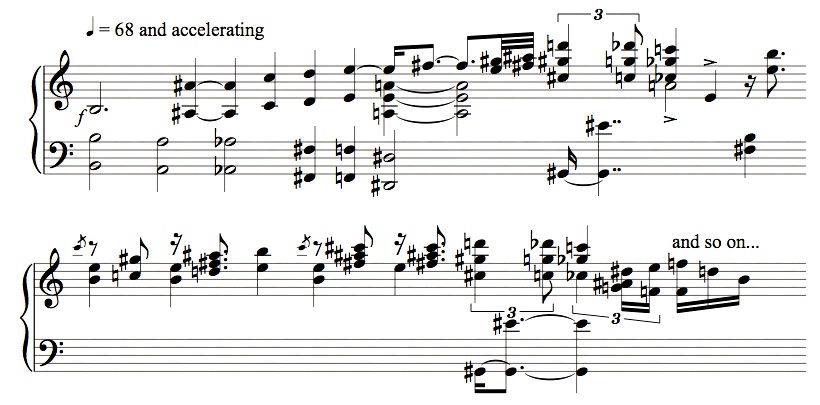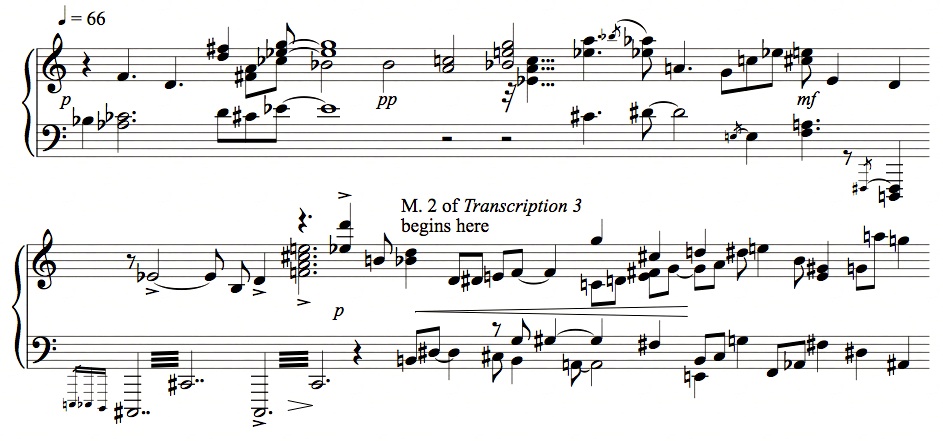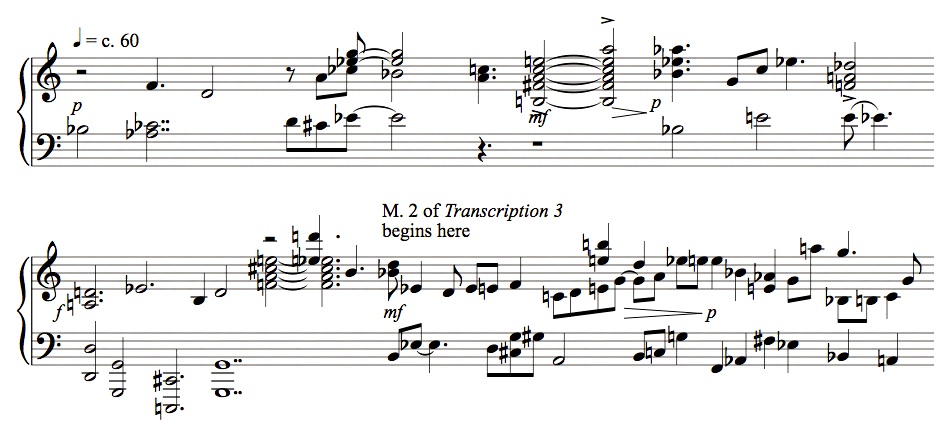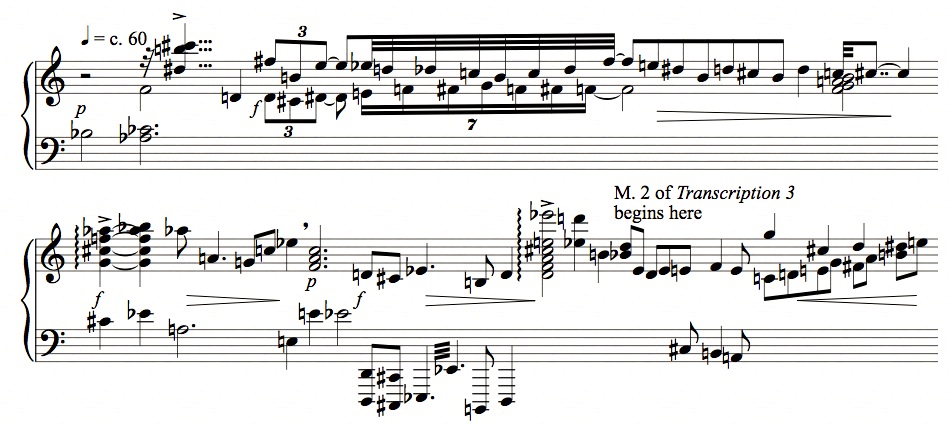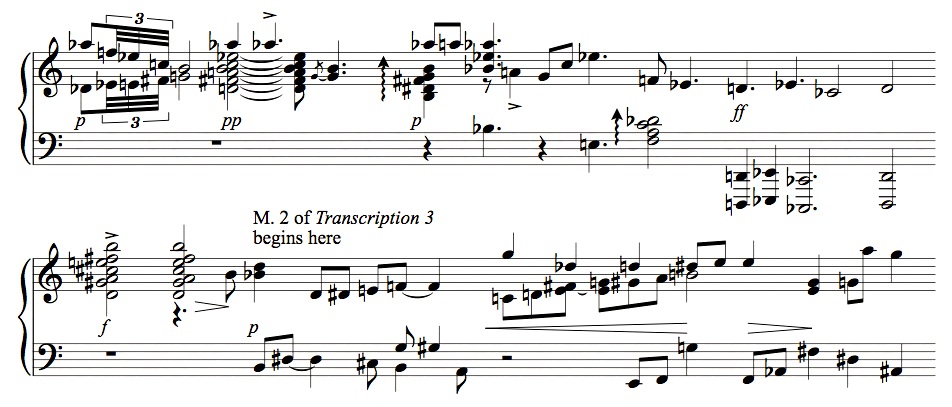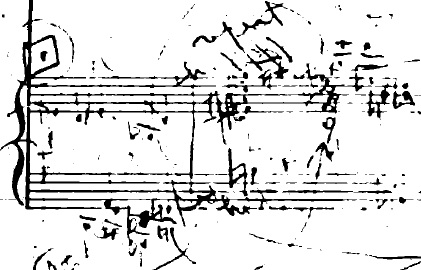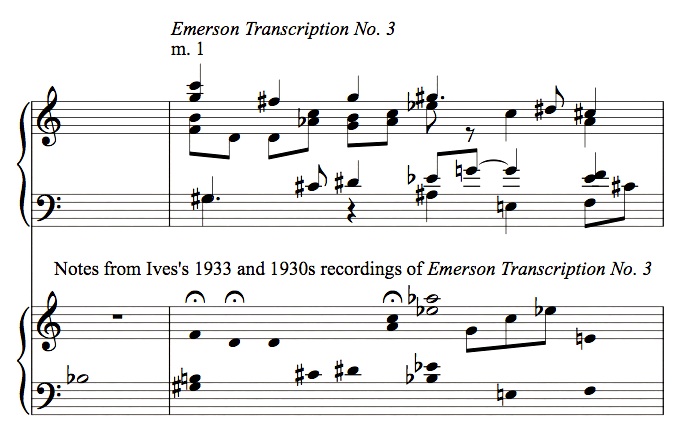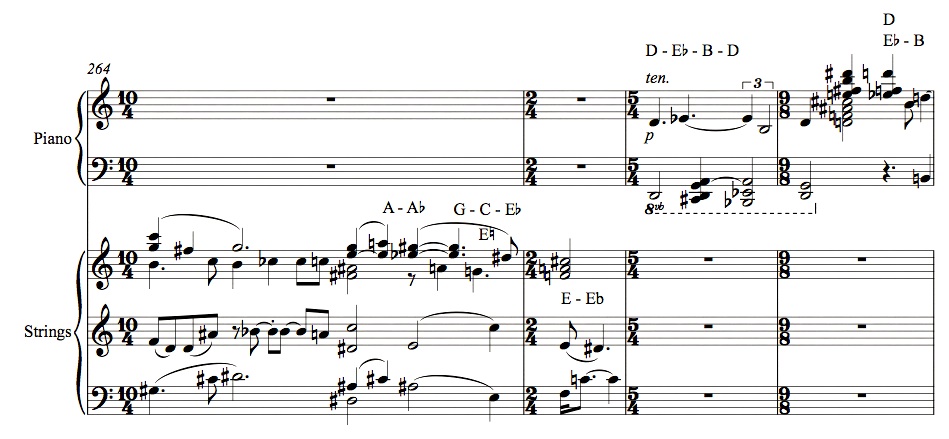For forty-five years, since I was a middle-schooler in Dallas, Ives’s Essays before a Sonata has been one of the most important books in my life. Lately it’s become tremendously underrated. Some Ives scholars have dismissed it nearly entirely as a jumble of psuedo-intellectual bloviations. The literature about the book has mined it piecemeal, a few sentences at a time, for insights into Ives’s biography, or to prove that he was highly influenced by Emerson and considered himself a Transcendentalist – or to prove the opposite. One of the themes of my book is that the Essays are undergirded by a more stable and coherent aesthetic project than Ives’s scattershot prose style leads one to suspect. As I rhetorically ask in the preface, “What if Ives had things to tell us, not about himself, but about musical creativity, that only a composer of his stature was in a position to know?” He was tremendously well-read and clearly spent years forming a rational justification for his compositional waywardness, and while his manner of verbal expression may not have been the most efficient for getting his points across, it’s clear that he deliberately wrote prose in a way analogous to the way he wrote music. The book is indeed kind of a mess, but so much of its language sends chills up my spine.
I’ve written here before about Henry Cecil Sturt (1863-1946), a rather undistinguished. post-Hegelian Oxford tutor whose essay “Art and Personality” Ives wrote the Essays partly in response to. The musicology world has virtually ignored Sturt, but more than a little of Ives’s rhetoric was borrowed from him even when Ives doesn’t acknowledge the quotation. The passages below are the run-up to the climax and the climax, though not the end, of my 15,000-word essay on Ives’s Epilogue, remarking on Ives’s relation to Tolstoy and Hegel as well as Sturt. Again, page numbers are from the standard edition of Essays before a Sonata. One of the things I’d love to accomplish with my book is to get the Essays taken more seriously than they ever have been.
* * * * * * * * * * * * * * * * * * * *
From Chapter 12: A Harmony of Imperfections: The Epilogue
The part of Ives’s argument that may have seemed most radical at the time is his separating off beauty from substance. Beauty has nothing to do with substance (p. 76), he affirms, and then gives examples of circular reasoning to show, a little disappointingly, that beauty can’t be defined. “The word ‘beauty’ is as easy to use as the word ‘degenerate.†Both come in handy when one does or does not agree with you [pp. 76-77].†In claiming that we can reach no consensus on the meaning of beauty, Ives may be following the lead of an 1898 book he had rather cursorily dismissed in the Prologue: Leo Tolstoy’s What Is Art? Tolstoy, preparing to encapsulate the entire history of the various theories of beauty, throws up his hands in advance over writers’ inability to define the term: “…after whole mountains of books have been written on the subject by the most learned and profound thinkers… the question What is beauty? remains to this day quite unsolved, and in each new work on aesthetics it is answered in a new way.â€[1]
Yet, despite this disclaimer Tolstoy, once he’s gone through definitions from an impressive wealth of historical treatises starting with Alexander Gottlieb Baumgarten’s Aesthetica of 1750, does manage to distill all the answers down to derivations of two fundamental concepts: beauty is a manifestation within an object of “the Perfect, of the Idea, of the Spirit, of Will, or of Godâ€; and that beauty is “a kind of pleasure we receive which does not have personal advantage for its object,â€[2] i.e., that is disinterested and does not create desire. (“Selfish pleasure,†writes Sturt accordingly, “is the death of art.â€[3]) His feigned complaint aside, Tolstoy ends up demonstrating that there is far more unanimity on the definition(s) of beauty, at least in modern times, than Ives follows up on. Likewise, these conceptions align with the definition given in George Santayana’s The Sense of Beauty, published in 1896 and based on lectures given at Harvard just prior to that. “Beauty,†Santayana concludes, “is pleasure regarded as the quality of a thing.â€[4] Moreover, as Sturt had also written, the perception of beauty has the subjective experience of seeming objective:
When I judge a thing to be beautiful, my judgment means that the thing is beautiful in itself, or (what is the same thing more critically expressed) that it should seem so to everybody. The claim to universality is… the essence of the aesthetic; what makes the perception of beauty a judgment rather than a sensation.[5]
Apparently, Tolstoy is the only other writer on aesthetics in the two centuries before Ives to deny beauty (defined as pleasure) a major role in the value of art. (Coming close, Sturt soft-pedals the role of pleasure, and defines beauty otherwise; “Beauty,†he writes, “is a kind of high vitality,â€[6] a more ambiguous phrase that Ives takes over from him.) Tolstoy considers the idea of beauty/pleasure as all-determining in art a perversion of the upper classes once they left traditional Christianity behind. He points out how often writers on aesthetics begin with a repertoire of approved artworks and then stretch the theory to fit them: “There exists an art canon according to which certain productions favored by our circle are acknowledged as being art… and the aesthetic laws must be such as to embrace all these productions.â€[7] The truth all these writers since Baumgarten have missed, by Tolstoy’s lights, is that the importance of art lies not the pleasure it gives, but in “the purpose it may serve in the life of man and of humanity.†He seizes on the common ability of one person’s narrative or means of expression to recreate his inner emotional state in, or transmit it to, another person, and concludes that, “To evoke in oneself a feeling one has once experienced, and having evoked it in oneself, then, by means of movements, lines, colors, sounds, or forms expressed in words, so to transmit that feeling that others may experience the same feeling – this is the activity of art.â€[8] Tolstoy’s corollary to this is, that as “Humanity unceasingly moves forward from a lower, more partial and obscure understanding of life to one more general and more lucid,†the best art is that which communicates feelings which will be most conducive to the spiritual improvement of society. And for Tolstoy, what determines the fruitful direction of spiritual improvement is the great truths of religion.
In a sense this is so parallel to Ives’s intent that I’m a little surprised he didn’t seize on Tolstoy as more of a potential ally. Both wanted to remove beauty/pleasure from the criteria for art and emphasize instead a perception of spiritual truth and inspiring example. It’s true that Tolstoy’s criteria were relentlessly Christian in a statically conservative way, and that, since for him aesthetic theory superceded individual works of art, Beethoven’s Ninth must be accorded bad music for perverted tastes because it was unintelligible to the common man: “I am unable to imagine to myself,†he wrote, “a crowd of normal people who could understand any of this long, confused, and artificial production, except short snatches which are lost in a sea of what is incomprehensible.â€[9] Though Tolstoy’s vision allowed for the improvability of mankind, it did not include the possibility of art that could be ahead of its time, that might be incomprehensible at first but understood later. And so Ives waves Tolstoy off completely: “From his definition of art, we may learn little more than that a kick in the back is a work of art, and Beethoven’s Ninth Symphony is not [p. 5].†It seems to me, though, that Ives and Tolstoy were theoretically similar in their aesthetics: the purpose of art for both was not to give pleasure (pleasure often being a symptom of a temporary perversion or “under-valueâ€), but to lead man toward further spiritual enlightenment. It was mainly their religions that differed, Ives’s being more ineffably mystical and less church-bound. Then again, Ives – writing a sonata that remains “difficult†to average listeners even a century after its completion – was surely uncomfortable with Tolstoy’s insistence that art should be understandable, and instantly understandable, to the working class…..
[1] Tolstoy, What Is Art?, p. 20.
[2] Tolstoy, What Is Art?, p. 41.
[3] Sturt, “Art and Personality,†p. 308.
[4] Santayana, The Sense of Beauty, p. 31.
[5] Santayana, The Sense of Beauty, p. 26.
[6] Sturt, “Art and Personality,†p. 313.
[7] Tolstoy, What Is Art?, p. 44.
[8] Tolstoy, What Is Art?, p. 51.
[9] Tolstoy, What Is Art?, p. 158.
* * * * * * * * * * * * *
It may seem peculiar, in retrospect, that Ives writes this long Epilogue to a book meant to accompany the Concord Sonata without any direct allusion to his own music (except, glancingly, in the second paragraph). Without seeming to make a special case for his own work, he is attempting to arrive at an aesthetic groundwork that will justify his deviations from musical normalcy. One passage from Sturt must have offered a particular point of identification, though he only quotes the second sentence of it: “Suppose that we come upon a strange artist who is producing work which he affirms to be art. The work may not be quite like any other work in the world, but it is art so long as he feels in doing it as true artists feel, and so long as his object is akin to the objects that true artists admire.â€57 Ives must indeed have felt like that “strange artist†he refrains from mentioning, the one whose “ears were on wrong,†and Sturt seems to offer the artist permission to make this judgment for himself. Accordingly, Ives needs to arrive at a viewpoint in which his own confidence in his music can be set equally against all those musicians who, over the years, thought he was doing something incomprehensible, if not amateurish or insane.
Sturt begins his essay with a complaint that aesthetics has too often been written about art experience from the viewer’s standpoint, and not enough from the artist’s.58 And Ives writes at times as though the validity of art lies less in the listener’s recognition than in the experience the artist had while creating it. “Whether he be accepted or rejected, whether his music is always played, or never played – all this has nothing to do with it – it is true or false by his own measure…. [p. 81]†And again, leading to the Sturt quotation, “The artist does feel or does not feel that a sympathy has been approved by an artistic intuition and so reflected in his work. Whether he feels this sympathy is true or not in the final analysis, is a thing probably that no one but he (the artist) knows but the truer he feels it, the more substance it has…. [p. 81]†As to the question of whether Debussy’s music contains substance, “Debussy himself, doubtless, could not give a positive answer. He would better know how true his feeling and sympathy was, and anyone else’s personal opinion can be of but little help here [pp. 80-81].†Ives veers close to admitting that the substance of music might not be entirely accessible to the listener, in a rather astounding statement: “what music sounds like may not be what it is [p. 84].â€
In this connection, Ives pulls a Hegel quotation from Sturt’s article, and it is one of his rare deliberate and admitted misquotations:
If we may be permitted to leave out two words, and add a few more, a sentence of Hegel appears to sum up this idea, “The universal need for expression in art lies in man’s rational impulse to exalt the inner…world (i.e., the highest ideals he sees in the inner life of others) together with what he finds in his own life – into a spiritual consciousness for himself [p. 81].”
This is from a passage that Sturt quotes at greater length, in which Hegel discusses the question, “What is man’s need to produce works of art?†Hegel’s answer is that man “reduplicates himself†“in order to strip the outer world of its stubborn foreignness, and to enjoy in the shape and fashion of things a mere external reality of himself.â€59 The original form of the sentence Ives takes pains to change (after unconcernedly misquoting so many other lines) is: “The universal need for expression in art lies, therefore, in man’s rational impulse to exalt the inner and outer world into a spiritual consciousness for himself, in an object which he recognizes as his own self [emphasis added].â€60
Now this is odd, coming from a composer who painted, in his music, a child’s Fourth of July, Manhattan’s Central Park in the dark, the voices of Americans singing a hymn at a train station after the sinking of the Lusitania – Hegel speaks of art as exalting the inner and outer world, and Ives pointedly deletes the “outer.†In addition, he appends his own new apposition to “inner worldâ€: “the highest ideals he sees in the inner life of others.†It is as though he is limiting substance to the inner world of someone, if not specifically of the artist himself, perhaps thinking that portraying the outer (physical) world – as Debussy did in La Mer, and Strauss in the Alpine Symphony? – comes too close to what he defines as mere manner. In any case, we’re in somewhat dangerous territory, aesthetically speaking, if only the artist him- or herself can determine with exactitude whether the sympathy and artistic intuition in an artwork rise to the level of substance. For if only the artist knows whether his own work is spiritually and emotionally true, what artist, speaking for himself, would confess otherwise? Perhaps Ives, with his long history of being told that his ears were on wrong and his music was distasteful, needed exactly this permission to make the determination for himself, and without external ratification. And what artist reading this – or writing it – can vouch with assurance that his or her creative experience was as intense as Ives’s?
Let us not shy away from Ives’s intent, nor politely assume that he couldn’t have meant to assert anything so heterodox, but grasp his point explicitly though it lead to absurdity. The entire force of his life might reside in his most extravagant claim. The artist has an experience while creating his art, and the spiritual intensity of that experience constitutes or determines the substance of the art. (This does not equate, we will remember, to feeling the specific emotions he may be depicting.) The listener to the music, the viewer of the art, may not recognize the quality of the substance – that is of no matter. Only the artist can “know how true his feeling and sympathy was, and anyone else’s personal opinion can be of but little help here.†We cannot found an aesthetics on the reception of the subjective and fallible, so often imperceptive, so easily misled, audience. Nor is it necessarily fatal if the artist lack the manner (the technique? the competency?) in which to communicate his or her vision, as long as the vision is embodied in the art. In the Prologue (p. 6) he speculates that “A true inspiration may lack a true expression,†though he admits that if it is not true enough to result in a true expression, we might have to conclude that “it is not an inspiration at all.†We perhaps find ourselves in the territory, mentioned in Ives’s Memos, of the old stone-mason John Bell, whose raucous and off-key singing George Ives excused to a parishioner who complained: “Don’t pay too much attention to the sounds. If you do, you may miss the music. You won’t get a heroic ride to heaven on pretty little sounds.â€61 (Ruskin’s “harmony of imperfections†comes to mind.) It was the fervency with which John Bell believed what he was singing, not its technical polish, that made it art. What has sound got to do with music? What music sounds like may not be what it is. There might be a great work of art, and only the artist knows about it – only the artist experiences it. In retrospect, in fact, this is a simple description of pretty much the state Ives was in in 1919, and had been for many years. It is a state many an artist knows at a moment of triumph alone in her studio.
Of course, what is desirable, what makes the slow, difficult, inconsistently remunerative process of art socially worthwhile, is that that private state is generally deemed temporary. The art is shown, the music is listened to, and through whatever process of neuron mirroring makes artistic perception possible and potent, a psychological process occurs that recreates, according to whatever inexact process of analogy, a frame of mind within the viewer or listener something like the one that was originally in the artist. Even the listener to old John Bell might be spellbound by the inspiring sincerity of his flawed performance. As Ives had already seen, this process is infinitely vulnerable to failure, and in the 1920s, as a result of mailing that sonata out, he was about to gather a huge new wealth of evidential experience. It was possible that no one would ever respond to the Concord Sonata in the way that Ives hoped. It is hypothetically possible, according to this theory, that there exists, somewhere in the world, a great work of art whose substance no one has ever perceived, that has gone unrecognized, that might even be inaccessible to anyone living. Perhaps what was important about it was that the artist had the experience. Perhaps the mere fact of having created the glorious, never-to-be-understood work would make its way into the collective unconscious and indirectly elevate mankind’s perception of art. In that sense, perhaps theory will have to eternally presume the artist innocent – at least, an artist who has created a work we don’t understand.
Ives’s own musical vision was validated in the end, though hardly universally; of all the world’s music lovers, it is a safe guess that only a relatively tiny percentage would choose to continue listening to the Concord Sonata. And what does the quantity or percentage of appreciative listeners matter? It is tempting, though useless, to wonder whether Ives might have formulated the point differently, could he have foreseen how much lasting and universal substance music lovers would have indeed found in his difficult music by the 21st century. Perhaps we must assume a Platonic world of art, inaccessible to general knowledge, of which the public reception of art is only an imperfect mirror. We can admit the theoretical point while also granting its pragmatic inutility. On the other hand, perhaps the mere recognition of that occulted Platonic realm might serve to inspire a little welcome humility among those who are so quick and confident to affirm that our musical society is an efficient meritocracy, and that the artists who get the most visibility, attention, and honors are certainly those who deserve them. Occasionally we find that it was not Louis Spohr who was so great, as we thought, but the obscure Franz Schubert; and who knows but that another Charles Ives might be composing unheard-of things, today, in isolation? If Ives can teach us that the public world of art is a mere caricature of the real thing, and that we should revere aspects of creativity that don’t seem obvious or available to us, perhaps that is a worthwhile and sufficient lesson for the Essays Before a Sonata.
57 Sturt, “Art and Personality,†p. 328.
58 See Sturt, “Art and Personality,†pp. 291-92.
59 Hegel, Introductory Lectures on Aesthetics, p. 36. One of Hegel’s examples in evidence is charming: “Even the child’s first impulse involves this practical modification of external things. A boy throws stones into the river, and then stands admiring the circles that trace themselves on the water, as an effect in which he attains the sight of something that is his own doing.â€
60 Hegel, Introductory Lectures on Aesthetics, p. 36.
61 Ives, Memos, p. 132.


